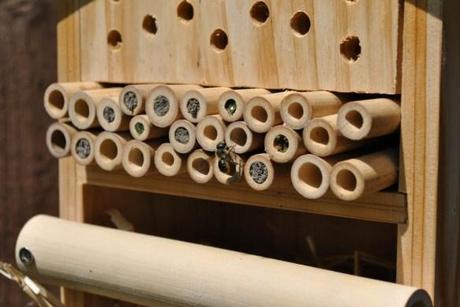As everything in the garden has been a tad late this year, we didn’t quite manage to harvest any strawberries in time for Wimbledon, but they are ripening off thick and fast now. Reaching into the bed to pluck my third – yes,third bowl of plump, juicy berries, something whizzed past my ear at lightning speed, with nary a care in the world for anything else that might be in its air space.
Looking up just in time, I spotted a bee with an armful of greenery, making a bee-line (sorry!) for the insect hotel we put up month or so ago. After what had seemed like a slow start to the season, it appeared we had guests for the summer. Watching carefully from a distance, the whole thing was a hive of activity. Bees were flying in from all directions, packing leaves into the tubular holes of the hotel.

Leaf cutter bees in the insect hotel
Last year we were lucky enough to have Tree Bees take up residence in the bird box, and I was slightly miffed that they hadn’t returned. But luck appeared to be on our side: we now have another type of bee to enjoy.
A quick scootle round the internet revealed that these new guests were Leaf Cutter Bees. They collect pieces of leaves from rose bushes and the like, and stick them all together with saliva, in small tubes. This provides the perfect habitat for their larvae to hatch. Bees apparently are on the decline, and are excellent pollinators, so I am more than happy to play ‘Hostess with the mostest’ to them.
Elsewhere in the garden, the broad beans are coming in thick and fast – so much so that I’m podding and freezing them straight after picking. The runner beans are a good few inches long, and not long off harvesting, and the courgettes and squashes are beginning to produce small fruits. In the greenhouse we have our first green tomatoes and chillies, and I’ve lost count of how many baby cucumbers have started to form. Cucumbers have male and female flowers. The male is a stalk with a flower and the female has a cucumber on the end. I’ve been picking off the stalky ones as have heard that they can cross pollinate and produce bitter crops.
With all this growth going on, I decided to invest in a tub of granulated feed, to give everything a helping hand. Before I could apply the feed, the patch was in desperate need of a good weeding session, as the aim was to feed the plants, not the weeds: as well as the annual ones that have popped up, I have enough mare’s tail to start my own pony club.
So, off I set to work, and before long had filled two plastic sacks. These went straight in the brown bin, as I don’t want to encourage some of the tough, perennial weeds to seed themselves in my compost bin, only to re-appear with a vengeance next year in the garden.

